Scientists and geologists have at least one thing in common – many of their greatest inventions and discoveries happen by accident.
Sometimes it’s better to be lucky than good, eh?
Paying attention pays off.
Northern Shield Resources (NRN, TSX-V) is fast becoming an overnight success story, one decade in the making.
Between 2007 and 2014 it plugged away, working slowly but surely on its 100%-owned Wabassi property in the western James Bay lowlands.
Small successes and milestones were achieved along the way, but Wabassi just wasn’t the project that was going to take Northern Shield to the next level. Ultimately, its remaining 49% interest was sold for a cash payment of $1.4 million in mid-2014. Northern Shield maintains a 0.5% NSR royalty on the Wabassi Property.
Perhaps deploying this newfound cash back into PGE exploration, Northern Shield’s fortunes began to turn just a few months later upon discovering the Huckleberry occurrence on the final day of a limited exploration program.
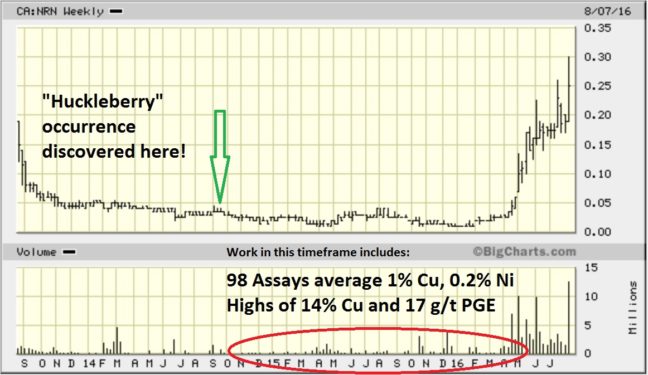
Obviously, at the time Mr. Market had no clue as to how important the Huckleberry occurrence would become. Looking at the chart above, after under-appreciating relatively strong assays from surface samples for many months, investors are catching on to Huckleberry’s significance quickly now.
It pays to pay attention, doesn’t it? (on that note, who owns all the claims contiguous to NRN and who did NRN also stake around?).
Looking for Ni-Cu-PGEs in “all the wrong places”…
For starters, Northern Shield’s geologists developed an unconventional theory that a massive Ni-Cu-PGE deposit could be located in the Labrador Trough, commonly known for its rich Iron-ore deposits. However, the Labrador Trough remains one of the geologically least explored regions of Canada. The area is covered by extensive sills and flows of basaltic magma, emplaced into and onto a thick package of sulphide bearing pelitic rocks, which does suggest the prospectivity for magmatic Ni-Cu-PGE ore deposits.
According to the story that’s fast becoming legend, Northern Shield’s chief geologist Christine Vaillancourt spotted a gossan in 2014 that stuck out like a sore thumb. The gossan was so obvious and massive looking from up above in a helicopter, Christine assumed it must have been claimed by someone already.
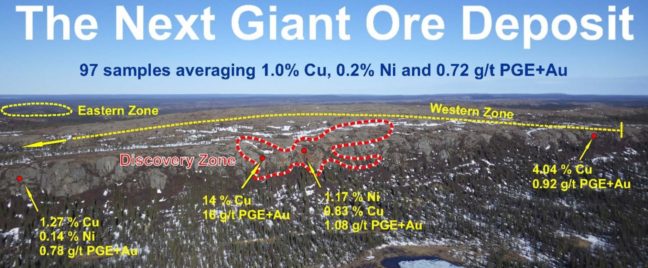
Had an approaching thunderstorm not threatened the safety of her flight, forcing a nearby landing, she likely would have passed right by Huckleberry (only to think “what might have been” for decades later).
As fate would have it, the thunderstorm allowed Christine and her crew to take rock samples from Huckleberry home for further review. Sample assays proved good. To top it off, not only was the property unclaimed – it had never been claimed before.
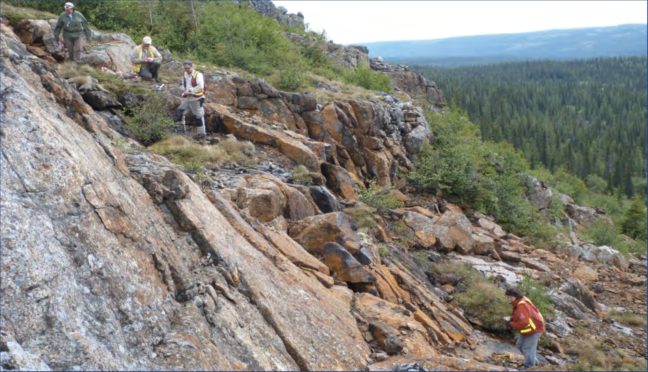
Truly amazing!
Ironic, too, because “all the easy discoveries sitting at surface have been made”. Have you heard that line repeatedly, or is it just me?
The harder you work, the luckier you get…
From the sounds of it, Huckleberry found Northern Shield just as much as Northern Shield found Huckleberry.
In fact, the story about how Voisey’s Bay was discovered is eerily similar.
Not unlike Voisey’s Bay, after spotting the gossan from helicopter things begin to progress quickly.
More extensive sampling turned up excellent results, and a review of historical information (airborne surveys, lake bottom sediment data) on the government’s website started connecting the dots. On June 7 of this year, Northern Shield signed an option agreement with South32, an Australian-based international mining company with a current market cap of $7.5 billion (U.S.).
Under the terms of the deal, South32, a spinoff from BHP Billiton, can earn a 50% interest in the Huckleberry by incurring $2.5 million CDN in exploration expenditures within the first 2 years of the agreement and by making an upfront cash payment to Northern Shield of $200,000. On successfully earning a 50% interest, South32 can elect to increase its interest to 70% by incurring a further $2.5 million in exploration expenditures by the end of the 3rd year. Northern Shield’s interest will be free carried to the completion of a PEA, and they’ll remain the operator while also earning a 10% management fee from South32 on all exploration expenditures by the major at Huckleberry.
“We are extremely pleased to be partnering with South32 on our Huckleberry Project, whom we believe sets the new standard for agility and dynamism amongst the globally diversified mining companies,” explained Northern Shield President and CEO, Ian Bliss. “Perhaps more importantly we share the same philosophy and strategy regarding the science of, and a model-driven approach to, exploration. Northern Shield has built up a significant and unparalleled knowledge of the Cu-Ni-PGE potential of the Labrador Trough and from the onset we have recognized that the geology and mineralization we see at Huckleberry stands out as being very different from the surrounding area and has positive indicators for large-scale magmatic Cu-Ni-PGE deposits. This transaction evidences that South32 shares the same optimism for Huckleberry.”
First drilling at Huckleberry begins later this month!…
While talking with Jon from BMR (I had to pick his brain about this unique situation), he shed some light on how he’s thinking about Northern Shield right now: “It is highly unusual for a major to a option a property from a junior at this very early stage, with no drill holes. All the boxes check off here in terms of the signatures one would want to see for a potential discovery. No guarantees, but it looks very good, about as good as it gets in the exploration business. Now the ‘truth machine’ goes to work.”
With South32 funding the first $5 million worth of work at Huckleberry, if they elect to fully exercise that option, it allows Northern Shield to keep its share structure below 200 million outstanding. Additionally, South32’s exploration work and brain power at Huckleberry will help Northern Shield better understand its 100%-owned Sequoi property for no cost.
Sequoi is located next door to Huckleberry, as you can see in the image below.
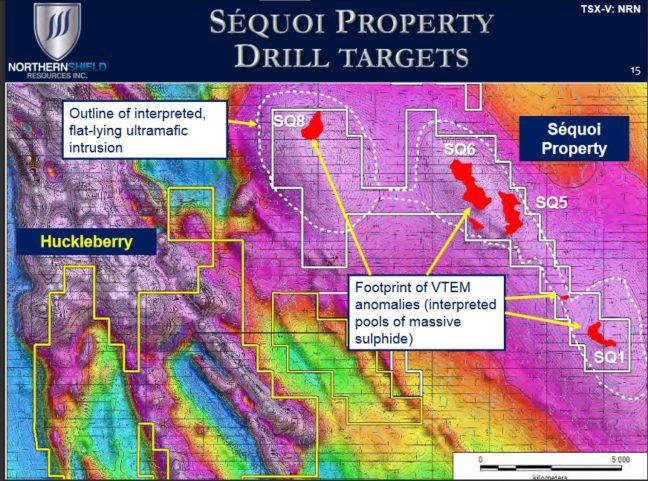
“The VTEM results are quite remarkable. One rarely sees geophysical results fit the geological model so well, especially in a blind environment,” explained Bliss in a news release last Monday (August 8) that further heightened interest in the play and the district. “We have a string of very strong and sizeable conductors. Their relative locations, geometry and conductance are consistent with our conduit model for magmatic massive Ni-Cu-PGE sulphides. We really could not be more pleased with the VTEM results and look forward to drill testing them.”
NRN’s plan is to drill Seqoui during the last half of September, following completion of drilling at Huckleberry.
Eyes wide open…
Huckleberry stands out as being a very complex and dynamic mafic intrusive complex, characteristics common in giant ore deposits. Evidence includes an abundance of brecciated rocks, xenolith, taxitic textures and multiple phases of mineralization. It appears to have all the earmarks of a large-scale “segregated” deposit with Copper followed by Nickel and PGE’s.
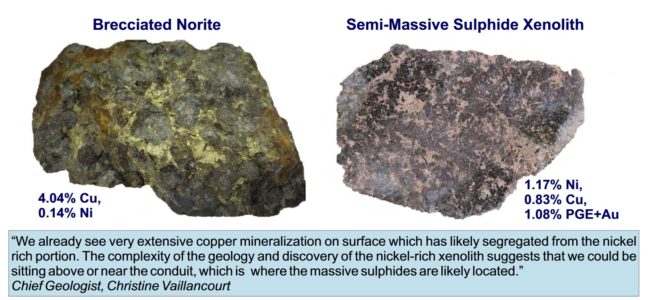
“Whenever we show these rocks to geologists that work in and understand magmatic systems, their eyes open up very wide when they see these types of textures in these rocks, because they’re all indicative of giant Nickel-Copper ore systems. Sequoi could be even bigger than Huckleberry,” declared Bliss.
With infrastructure in place nearby for the Iron-ore mines, Northern Shield’s Huckleberry and Sequoi Projects are strategically located should either or both warrant advancing toward development.
While the Venture is up 80% from its all-time low in late January, the fact is we’ve yet to see a national headline-grabbing major new discovery in this young new bull market. The Huckleberry and Seqoui have to be considered potential candidates for that, which still leaves plenty of speculation on the table over the coming weeks despite Northern Shield’s impressive share price advance so far.
The other very intriguing angle to this story…
How Clean Commodities‘ (CLE, TSX-V) Ryan Kalt was able to carve out such a large slice of this southern Labrador Trough district, surrounding both Huckelberry and Sequoi, is worthy of a separate article as it has given CLE a potential company-changing tenure position of hundreds of square km.
Kalt stated to BMR, “We have a significant tenure and project presence on regional structures where Northern Shield is drilling this summer and fall. That tenure position is in good standing through the middle of 2018 which provides significant flexibility to CLE, both in terms of work scheduling and assessing the ongoing exploration results of our neighbor. It is also worth pointing out that Northern Shield recently staked ground around ours in the area, which in our opinion speaks to a revised understanding of a larger potential district-concept having significant exploration potential.
“Northern Shield has advanced the belief that the magnetic structure beneath their tenure (and ours) is an ultramafic body. When we look at examples of other deposit-hosting ultramafic intrusions globally we see that mineralization often occurs at the edge of the ultramafic, near the structural intersection with the country rock. Based on the proposition advanced so far by Northern Shield, CLE’s property covers more of this potential edge boundary of the ultramafic than NRN does. Plus, CLE holds significant tenure inside the boundaries of NRN’s proposed ultramafic structure that hosts their Sequoi Project. Consequently, we believe that our Labrador Trough Project – which surrounds not only NRN’s Sequoi Project but also their Huckleberry Project – will be an exploration priority for CLE.”
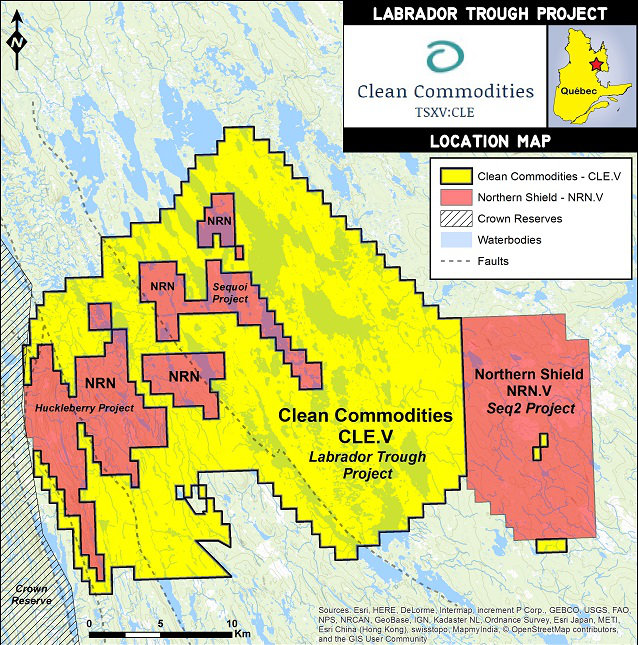
Investors would be wise to follow developments in the southern Labrador Trough very closely in the days and weeks ahead.
About the writer: Daniel T. Cook, the newest member of the BMR team, is from the great state of Texas. Daniel has a strong passion for the junior resource sector and has followed the Venture and broader markets with great interest since he bought his first stock 18 years ago at the age of 12. He’s also a licensed investment professional who was a Bright Future’s Scholar at the University of Central Florida, graduating in 2010 with a major in Finance. We know our readers will enjoy his material and benefit from his wisdom and insight. We welcome him aboard!
Note: Jon holds share positions in both NRN and CLE. John holds a share position in CLE.

1 Comment
Now own more shares in NRN and also picked up shares in CLE this morning. This is more than eye popping. Not only do they have the geophysics but the samples to boot. Like you said earlier Jon, it it looks like a duck, quacks like one, then it’s a duck. This is very different than EQTs property south of Voisey Bay. What really caught my attention as well were the number of Lake sediments at Huckleberry compared to what was at Voisey. It’s no comparison. Huckleberry and Seqouis is massive compared to Voisey. Now the truth machine will be the drill bit, but feeling very confident they will make a major discovery.